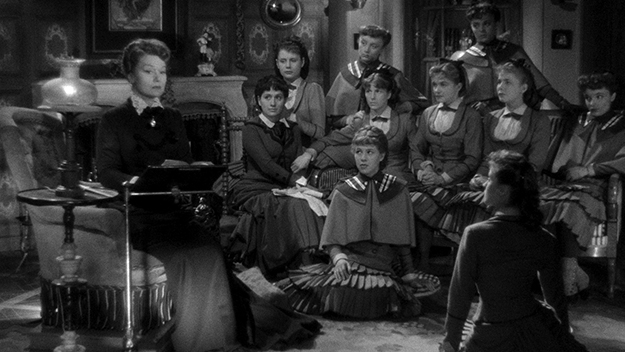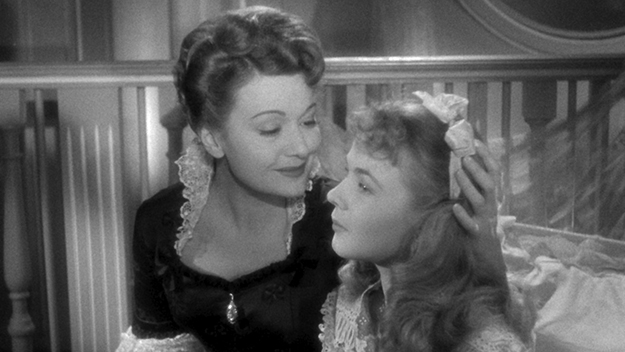To hear many male critics tell it, lesbians were invented sometime in the 1970s, alongside women’s rights and the clitoris. The aggressively ahistorical nature of this attitude (and we all know it’s ahistorical, yes?) is as much a result of the lack of availability of non-mainstream films pre-1970—ones that were not made, produced by, or centralizing white men—as well as the codes of censorship that limited what could be depicted and what films received wide distribution. One of the victims of American censorship, at least, was Olivia, a sumptuous 1951 film about lesbian desire and love triangles in a 19th century girls’ school. The film was made by seminal female director Jacqueline Audry, written by Audry’s sister Collette Audry, and based on a novel by fin-de-siecle bisexual author Dorothy Bussy—a trifecta of femine art. It’s a study in female relationships, their complexity, and the centralizing of female desire, couched in the form of a complex gothic melodrama that prizes women above all else.

The film follows English schoolgirl Olivia (Marie-Claire Olivia), who leaves home to attend a finishing school in the outskirts of Paris. She enters into a complex situation—the school is divided into supporters of the headmistress, Mlle. Julie (Edwige Feuillère), and the school’s other founder, Mlle. Cara (Simone Simon). The pair have a complicated relationship—while never stated openly, it’s heavily implied that they are lovers and have been for some time—made more complicated by Cara’s consistent illnesses and Julie’s apparent seduction of numerous girls at the school. Olivia begins to fall in love with Mlle. Julie, even as she learns that some of Julie’s previous favorites, including both teachers and pupils, have been thrown over and remain obsessed.
Olivia does not shy away from the complexities—and the discomforts—of these relationships. The school is an autocracy ruled by women, and within it are personal relationships that overlap with educational ones. Julie’s hold on Olivia and other girls is educational, foundational, and, at times, predatorial. She regularly holds readings in her rooms, reading from Racine’s Andromaque and other classics; she takes Olivia to Paris, showing her artwork, educating her in cuisine and life lessons. The power which Julie has over the girls and over the other teachers complicates the eventual breach into romantic and sexual relationships—she promises Olivia that she’ll “come to you,” and openly embraces another girl on the ballroom floor.
The film never explicitly uses the term lesbian, or any similar terms. It does, however, make clear that the relationships depicted are both passionate and sexual, even if not all are consummated. The gothic nature of the narrative is similar to male-centric narratives, in the sense that it tells of a young girl/woman away from home, isolated in an opulent space, who falls under the spell of a powerful older person. The fact that this is specifically about women, within an exclusively female space, is a unique offshoot of the gothic narrative structure (not unusual in literature, but less usual in film). The film couches Mlle. Julie as a predator, in part, but also an educator. Mlle. Cara is a languid figure, constantly complaining and searching for sympathy, but it becomes increasingly clear that her anguish is directly tied to her partner’s constant seduction of other women, and her own deep need to be loved. Mlle. Julie has made Mlle. Cara what she is.

The passionate undercurrents of Olivia finds expression in the sumptuous set design and costuming, every room replete with 19th century furnishings, opulence, and elegance. This a frilly, feminine world, a world in which women rule. There are no named male characters; only three men speak during the course of the film, and they remain faceless, nameless figures of authority, black-clad impostors onto the sanctity of female space. Their presences are not really necessary or desired, and it is before them that the women, who have debated, squabbled, and grown jealous over the course of the film, close ranks and decline to indict one of their number. The secondary characters also have their passions—there are numerous depictions of the girls playing and dancing together, learning things from each other. The mathematics teachers despises her own subject and indulges her passions in food—a substitute for sex and desire, as she herself states.
Olivia is a groundbreaking work of female filmmaking and depiction of lesbian relationships, while still problematizing the idea of a headmistress using her power over young girls. Even with its occasional flaws and the limitations of its era, it is a searing and complex examination of power and desire, of adolescent yearning and transformation. It deserves to be seen—and, thankfully, now we can finally see it.
Olivia is streaming on The Criterion Channel.


Damestruck: Olivia (1951) — Citizen Dame | FEEDBACK Female Film Festival
[…] via Damestruck: Olivia (1951) — Citizen Dame […]